1. Use Beehiiv to manage & grow your newsletter.
2. Growing a newsletter, can help you increase and sales.
3. Use 3 step strategy to generate leads, or best, sales using a newsletter.
According to Statista, the SaaS market is estimated to be worth $247 billion by 2025.
The problem? The competition is fierce. Everybody wants attention. Everybody wants sales.
Is there a way to dominate?
Yes. A 3-step strategy that will not only get you organic traffic but also help you generate leads that can be converted to sales.
All this, using your existing newsletter.
If you have an existing newsletter and don’t know what to do with it, this post is for you.
If you don’t have one, start one. Consider using Beehiiv. It is the most “creator-friendly newsletters platform”. You can still apply the strategies mentioned in this post.
It’s just that it will take some time to see results. However, the strategy mentioned in this post is bound to work.
With that said, let’s jump into the post.
How does creating a newsletter help you increase sales for your saas?
Creating a newsletter can significantly help you, as a SaaS founder, increase sales by providing a direct and personalized communication channel with potential and existing customers.
Here are some practical ideas, supported by real-world examples, on how newsletters can be leveraged for sales growth:
#1 Direct Communication and Relationship Building
Newsletters allow SaaS founders to communicate directly with their audience, bypassing third-party platforms and algorithms. This direct line of communication helps in building and nurturing relationships with subscribers, which is crucial for long-term customer retention and loyalty.
For example, Buffer, a social media management tool, uses newsletters to thank customers and highlight new features, making subscribers feel valued and informed.
#2 Educating Customers and Demonstrating Value
By consistently providing valuable content, newsletters can educate subscribers about the product’s benefits and use cases. This helps potential customers understand how the product can solve their problems, increasing the likelihood of conversion.
Box, a cloud content management platform, effectively uses newsletters to share product updates and educational content, helping customers make informed decisions.
#3 Personalization and Segmentation
Personalized newsletters that cater to the specific needs and interests of different audience segments can significantly boost engagement and conversion rates. By using customer data, SaaS companies can tailor content to different subscriber groups, ensuring relevance and increasing the chances of sales. For instance, newsletters that include product recommendations based on user behaviour can enhance the user experience and drive sales.
#4 Driving Traffic and Engagement
Newsletters can be used to drive traffic to a SaaS company’s website or landing pages, encouraging subscribers to explore more about the product. Including links to blog posts, webinars, or product demos can engage readers and guide them further down the sales funnel.
HubSpot, for example, uses newsletters to share valuable content that drives traffic and engages its audience, ultimately leading to increased sales.
#5 Measuring Success and Optimizing Strategies
SaaS founders can track key metrics like open rates, click-through rates, and conversions to measure the success of their newsletter campaigns. This data-driven approach allows for continuous optimization of content and strategies, ensuring that newsletters effectively contribute to sales growth.
By regularly analyzing these metrics, SaaS companies can refine their approach to maximize engagement and conversions.
Unorthodox strategy to increase SaaS sales with a newsletter
#1 Create a lead magnet(s)
The easiest way to start building an email list is to create a lead magnet. Depending on the industry you’re into, the nature of lead magnets would vary.
Your lead magnet can be an ebook, a checklist, an email course or a bunch of resources your target audience would want to have right now!
Before you jump onto creating lead magnets, I have a question for you. What are you going to create to capture leads?
*crickets*
No idea?
I recently helped a startup generate leads using this strategy.
Here’s what I did for them:
- Identify problems your target audience has. These are problems that they want to get rid of right now.
- Use AI to come up with lead magnet ideas around those problems.
- Again, use AI to come up with content ideas around those lead magnets.
That’s it.
With your audience’s problems in mind, here are some crazy ideas for lead magnets (applicable to any SaaS product):
- Virtual Escape Room Challenge: Design an online escape room themed around your industry. Participants solve puzzles related to your product’s benefits or features. Completing the challenge could unlock a special offer or free trial. This engages users in a fun way, encouraging them to learn more about your product.
- AI-Powered Personalization Tool: Offer a tool that analyzes a potential customer’s data to provide personalized recommendations or insights. For example, a SaaS marketing company could provide tailored strategies based on the user’s current marketing efforts. This valuable, customized insight can entice users to sign up for more information.
- Gamified Learning Modules: Create interactive, game-like modules that teach users how to solve common problems in your industry using your product. Completing modules could earn them points or badges, leading to a reward like a discount or exclusive content. This keeps users engaged while showcasing your product’s capabilities.
- Virtual Reality Product Tour: Develop a VR experience that allows potential customers to explore your product in a virtual environment. This immersive experience can help users understand the product’s value and encourage them to sign up for a real-world trial or demo.
- Mystery Box Subscription: Offer a subscription to a “mystery box” of digital resources, tools, or content related to your industry. Each month, subscribers receive a surprise package of valuable materials, encouraging ongoing engagement and interest in your product.
- Crowdsourced Solution Hub: Create a platform where users can submit their biggest challenges related to your industry, and other users can vote on solutions. The most popular solutions could be turned into a free resource or tool, encouraging users to participate and engage with your brand.
- Interactive Roadmap Builder: Provide a tool that helps users create a personalized roadmap for achieving their goals using your product. This step-by-step guide can highlight your product’s features and benefits, encouraging users to explore further.
- Digital Scavenger Hunt: Organize an online scavenger hunt where participants search for clues related to your product across your website and social media channels. Completing the hunt could lead to a reward, such as a free trial or exclusive content, driving traffic and engagement.
- Custom Avatar Creator: Allows users to create a custom avatar that represents their brand or business, using elements related to your product. This fun and creative tool can encourage users to share their avatars on social media, increasing brand visibility and attracting new leads.
- Predictive Analysis Report: Offer a report that uses predictive analytics to forecast trends or outcomes in your industry. Users can input their data to receive a customized report, showcasing your product’s analytical capabilities and encouraging them to explore further.
#2 Start writing newsletter editions
Although I knew how to grow an email list for a very long time, it was not until recently that I took it very, very seriously. With all the chaos happening with Google, one thing is certain: free platforms don’t owe you anything.
Their priority is nothing more than their profit, and it is my responsibility to own my audience and not rent it. You, too, should consider owning your audience.
Here’s how I’m growing my email list:
#1 Create an idea database
Once every week, for 10-15 minutes, I would collect ideas for my newsletter. These can be from LinkedIn, Medium, Reddit, active & passive research, etc.
I save all the ideas in Notion. These ideas are focused on one theme.
I write newsletters for solopreneurs, sharing SEO insights, industry news, tips & resources. Therefore, I focus on topics related to solopreneurship and SEO.
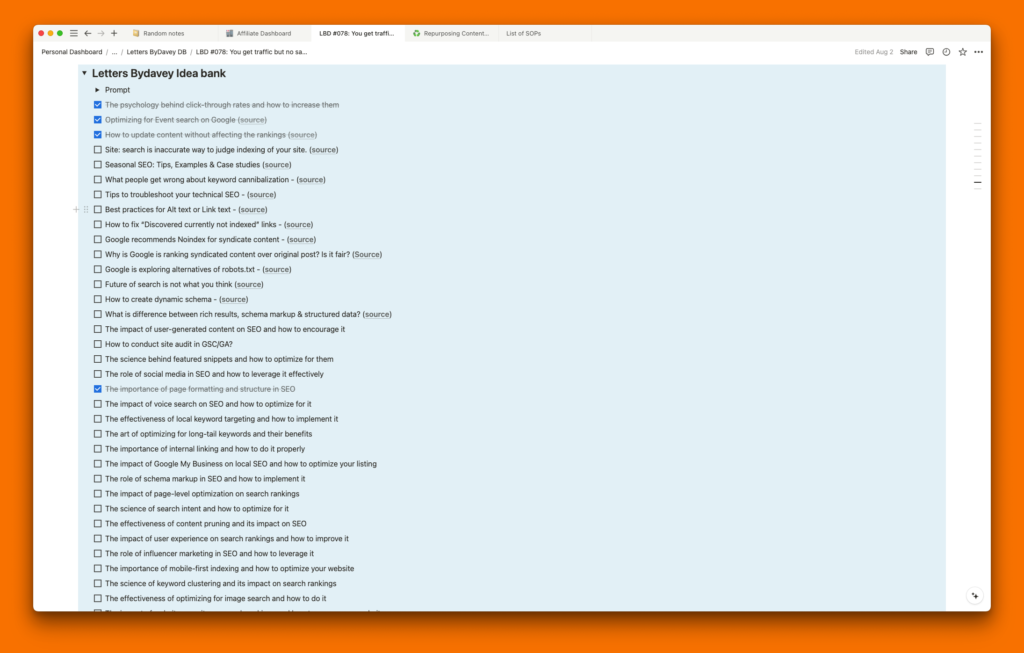
You should identify 2-3 such topics and look for content ideas on LinkedIn, Twitter, Reddit, Quora, Medium and more. These platforms can also be used for promoting the newsletter editions, which we will explore in subsequent steps.
Depending on the number of times you decide to send newsletter editions, you should collect ideas in advance to never waste time thinking, “What should I write?“.
#2 Write newsletters fast
I’ve practiced enough to prepare a newsletter edition within 60-90 minutes. Because my newsletter editions are readable in under 3-4 minutes, writing the edition in 60-90 minutes is easy.
Here’s a simple formula/template I use every single time:
- One core point: Be it a blog post or newsletter edition, I never talk about more than one core point. You should, too.
- A few resources: To back my core point, I find resources (articles, YouTube videos, Tweets, Surveys and more) from across the web. Previously, I used to do it manually, but now I use Perplexity AI for research. Saved a lot of my time, which is 🔥
- Three tips: I don’t want my readers to feel overwhelmed. I restrict myself from sharing more than three tips per edition about the topic.
- Simple body: Since I share SEO tips in my newsletter, I follow a simple format for all my newsletter editions, “tell them what to do & show them how to do it.“
- Interesting reads: I write on Fridays, and I collect interesting reads throughout the week for the upcoming edition.
- Expert opinion (optional): Occasionally, I reach out to influencers in the SEO industry to get their quote on the topic. This adds immense value to the edition, plus I can request the influencer to share my newsletter with their audience.
This doesn’t take more than 90 minutes for me. Initially, you might feel that you’re slow & might feel like giving up.
Don’t.
It gets better with time. Keep practicing, and you’ll get better. Use the simple format I’ve shared above to get started. Improvise later.
#3 Promote on social media
No matter how well you’re on search engines, it takes time to start getting organic traffic. Either way, you should promote your newsletter editions on social media.
I schedule all my posts in advance. I’m active on LinkedIn & Twitter to promote my newsletters, services and blog posts. I use Typefully to schedule all my content. At the point of writing this post, I’ve scheduled 143 posts and published nearly a thousand posts.
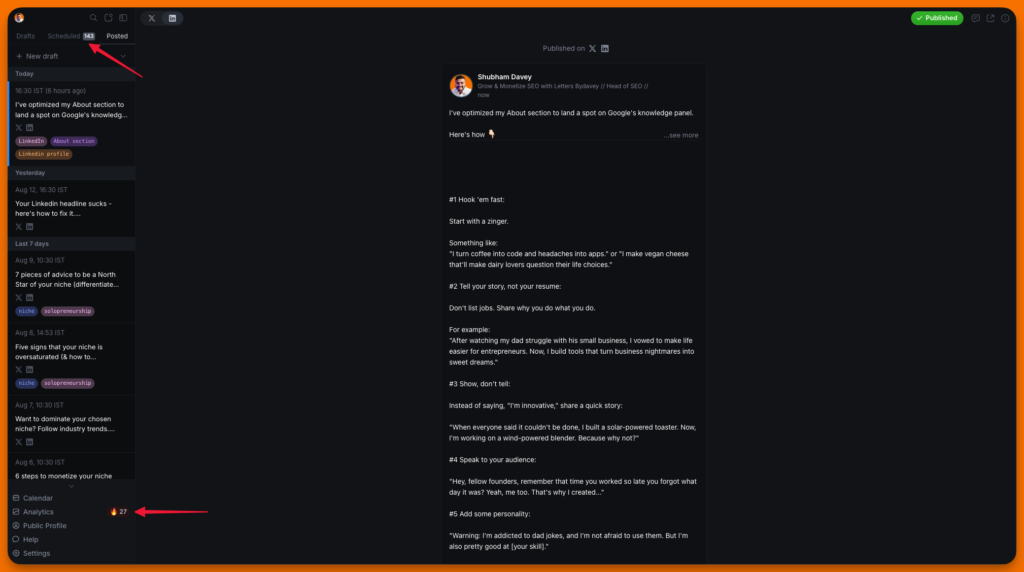
Here’s how I repurpose & the schedule I follow:
- Create quotes as image
- Break sub-headings & share them as individual posts
- Use AI to generate alternative angles of the post for repurposing
- Find relevant questions under “People also asked” for the target keyword
For scheduling, I have a simple plan. I scheduled the newsletter for Saturday, and the first post will be published on Sunday. I then reschedule the same post to be published after a month, six months, a year and two years from the date of publishing the first post. Until the next edition is published, I promote the latest edition till Friday.
Six posts promoting 1 edition, bringing in new subscribers for years to come. This happens for every single newsletter edition that goes live.
I prefer to write only on evergreen topics. With that in mind, the posts scheduled for the future will still be relevant at the time of publishing.
#4 Grow & Scale audience
I have various formats to promote my newsletter. The newsletter editions I published in 2024 will be promoted even in 2026.
At the time of writing this post, I’ve explored only LinkedIn & Twitter to repurpose my newsletter editions. I have Medium, Pinterest & YouTube on my radar, which I will explore next.
You can test platforms that suit your needs & most importantly, you should know for a fact that your audience is spending their time on that platform.
Related: Twenty ways to monetize your newsletter
What to do in your SaaS newsletter?
Let’s talk about the heart of this post. Let’s explore a basic format that you should follow to successfully use a newsletter for your own benefit.
#1 Pick a theme
There’s an ocean of newsletters out there wanting to grab the attention of your target audience. (Sad!) How will you differentiate yourself in that ocean?
I’ve personally struggled with this question. A lot. I paused writing newsletters to gain clarity on this. I don’t want to bore the hell out of my readers with the same old garbage that’s already covered to death online.
Picking up a theme helps you be free from thinking about what to write. You look for stories that only match the theme and reject everything else.
Here are some examples of themes for your newsletter:
- Industry news & trends: Keep your subscribers informed about the latest developments in your industry. This theme helps establish your brand as a thought leader and keeps your audience engaged with relevant content. Sharing insights on emerging trends can also highlight how your product stays ahead of the curve.
- Product Updates and Feature Highlights: Regularly update your subscribers about new features, improvements, and upcoming releases. This theme keeps your audience informed about the value your product offers and encourages existing customers to explore new functionalities. Highlighting how a new feature solves a specific pain point can drive interest and usage.
- Interactive Content and Surveys: Engage your audience with interactive elements like quizzes, polls, and surveys. This theme encourages active participation and provides valuable feedback that can guide product development. For example, a survey asking about desired features can make subscribers feel involved in shaping the product’s future.
- Educational Content and How-To Guides: Provide valuable insights and practical advice related to your industry. This theme positions your brand as an expert and helps your audience solve problems, which can build trust and encourage them to explore your product further. For instance, a newsletter from a project management SaaS might include tips on improving team collaboration.
#2 Tell stories
I’ve found a huge gap & I think I might have hit the jackpot.
I’ve used a simple philosophy to reframe my newsletter.
People hate being schooled. Don’t educate them, guide them. Tell stories of how others like them do what they want to do. There’s serious FOMO in that. These are not case studies; they are stories. Stories of real people with real results.
Stories as a theme for a newsletter are the best thing you can have to win. What type of stories you want to share is something you should figure out for yourself.
#3 Subtly promote your product
Promote your content as an obvious solution to the problems discussed in your edition. Find a way to bind the problem and a feature of your SaaS as a solution (don’t include made-up scenarios).
I use this trick for affiliate products. Basically, I come up with a CTA that matches the context of the post. This way, I get to promote the affiliate product without being salesy.
Pick any major SaaS blog, and you’ll find this trick.
Take Optinmonster, for example.
Check out the post below. It shows a CTA in the sidebar, attracting users to sign up as paid customers. The sidebar is visible throughout the page and is very prominent for the business.
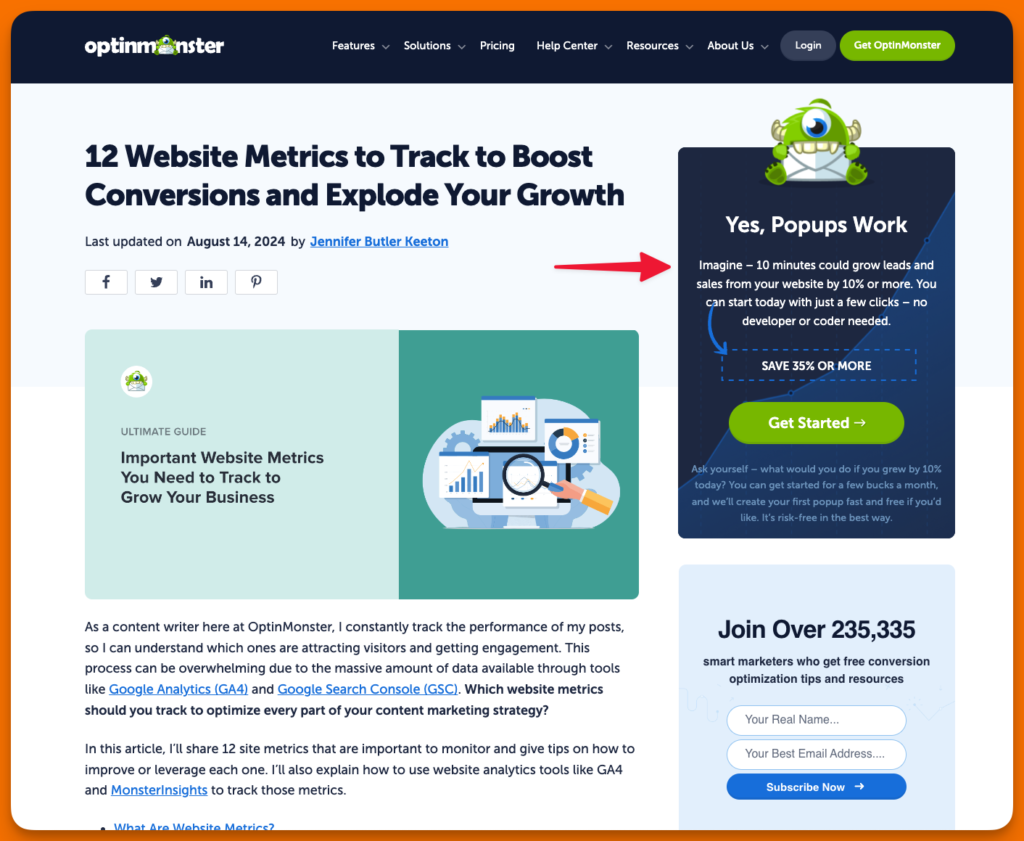
Here’s another example from the same post.
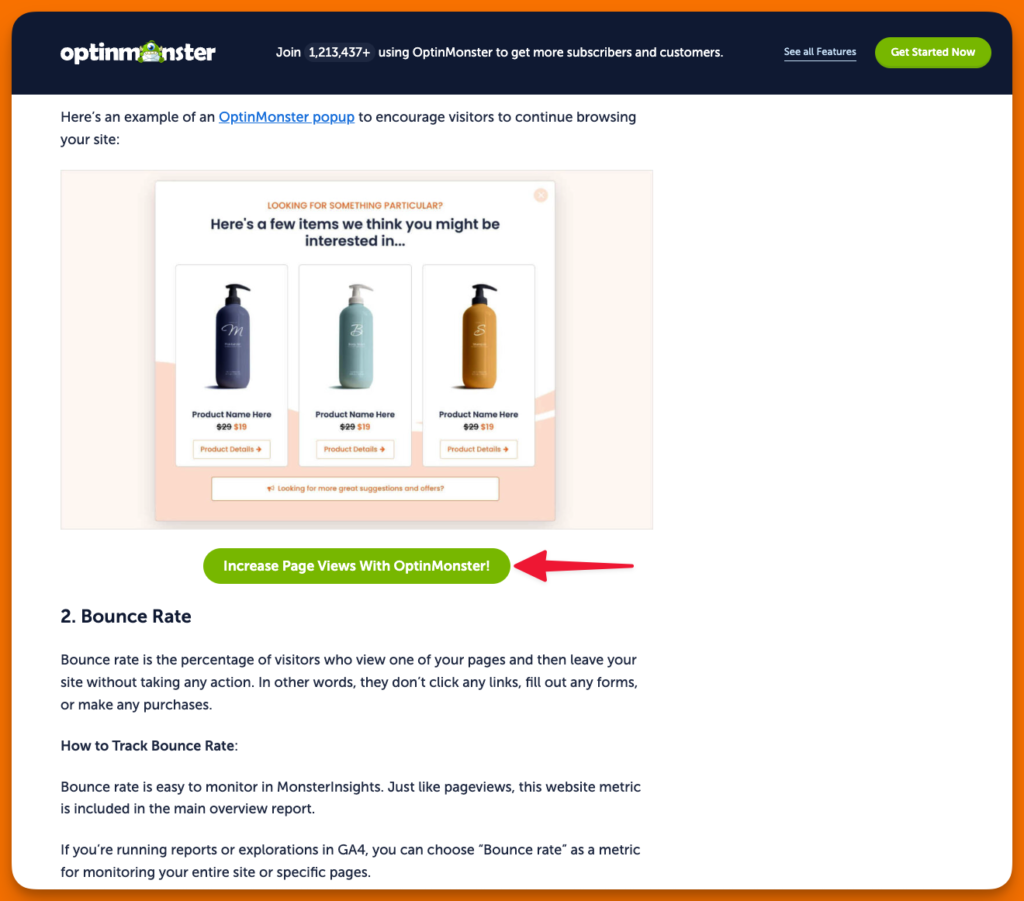
Within the post, Optinmonster has added contextual CTA buttons that remind users to check out the paid product.
You can use this trick too.
Ready to control sales for your SaaS?
The reason why newsletters work well, especially for SaaS, is the fact that you get to talk to your audience 1-on-1, with no distractions and no ads.
If you apply a simple framework that involves identifying problems, creating lead magnets and then creating content around those lead magnets, you’re bound to win big in terms of organic traffic and leads.
The only thing you have to spend time on is identifying your audience and then their problems. Everything else can be outsourced to AI, of course, with human supervision.

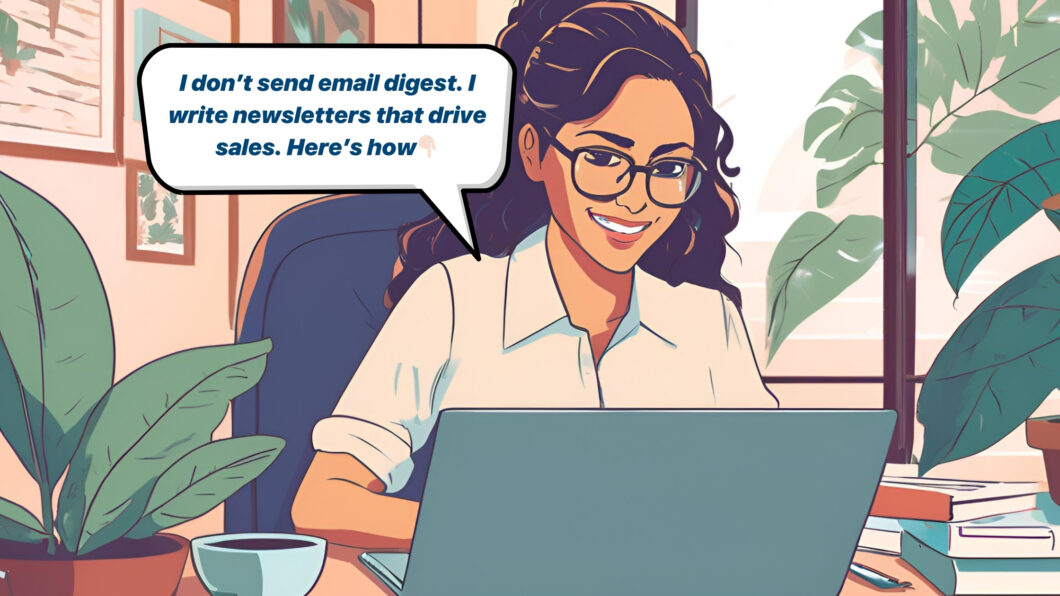
Excellent blog here Also your website loads up very fast What web host are you using Can I get your affiliate link to your host I wish my web site loaded up as quickly as yours lol
Consider using WPX or Kinsta